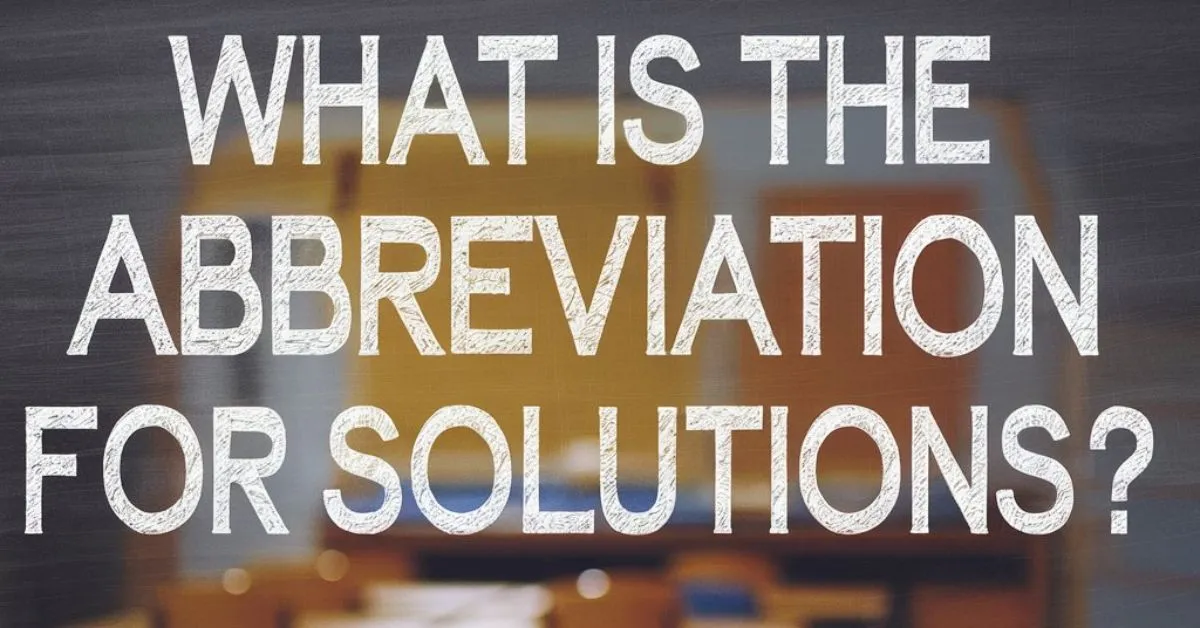The common abbreviation for “solutions” is “sols.” This shortened form is frequently used in various fields, especially in technical, scientific, or business contexts, to save space and improve clarity.
It allows professionals to convey the idea of solutions more efficiently without losing meaning. Whether referring to problem-solving methods, chemical solutions, or business solutions, the abbreviation “sols” helps streamline communication.
Example in Context:
- The company provided innovative solutions to address the client’s technical challenges.
- Our team specializes in delivering customized solutions for complex business problems.
What Does Solutions Mean?
“Solutions” are simply ways to solve a problem, tackle a challenge, or meet a need.
In various contexts, it can mean practical ways to address issues, fulfill requirements, or solve questions.
For example
In science, a solution can refer to a mixture where a substance is dissolved in a solvent, while in business, it often means strategies or products designed to meet specific goals. Essentially, solutions are means of providing relief or achieving a desired outcome.
ALSO ASK. What is the Abbreviation for School?
Definition, Pronunciation, and Examples
Definition:
“Solutions” are answers, methods, or strategies designed to solve problems or meet needs. It can also refer to mixtures in chemistry, where a substance is dissolved in a solvent.
Pronunciation:
“Solutions” is pronounced suh-LOO-shuns. Breaking it down helps make it easier to understand.
- Su sounds like “such.”
- Loo sounds like “loo” (yes, like the bathroom!).
- Shuns are as simple as they look “shuns.”
Examples:
- The company developed innovative solutions to improve customer service efficiency.
- In chemistry, a saline solution is a mixture of salt dissolved in water.
Short and Sweet: The Abbreviation SOLUT
SOLUT abbreviation meaning:
In business, “SOLUT” can refer to services or products that address specific client needs or challenges. Companies often use it in marketing materials to highlight their ability to offer effective solutions. The abbreviation simplifies communication, making it quicker for audiences to grasp key messages.
In the context of technical and scientific fields, “SOLUT” may appear in discussions about chemical solutions or methodologies. It’s a shorthand way of referring to mixtures or the process of solving complex issues. This usage ensures clarity while maintaining a professional tone.
Real-Life Example:
- The tech company launched several SOLUT that streamlined the customer support process, making it more efficient.
- In the lab, the researchers prepared a saline SOLUT to test the reaction of the substance at different temperatures.
Acronym for Solutions
SOLUT in abbreviation
There isn’t a widely recognized acronym for “solutions” that is used universally across industries. However, in specific contexts, companies or organizations may create their own acronyms or abbreviations based on the word “solutions.” For example:
- SOLS ;Often used informally in business or technical settings to refer to “solutions.”
- S2 :Sometimes used as a shorthand for “Solutions” in branding or marketing, though not standard.
Solutions acronym
Some industries may use their own specific abbreviations. The most common abbreviation for “solutions” is “SOLUT,” often used in marketing and technical settings. This abbreviation conveys the essence of offering solutions in a more compact form.
Other Examples of Abbreviations Related to Solutions
Here are some other abbreviations related to “solutions” that you may encounter in various contexts:
- SOLS ;A common abbreviation for “solutions” in business or technical contexts.
- SOL ;Sometimes used in shorthand, especially in informal or internal communication.
- S2 ;Used in some branding or marketing materials as a shorthand for “solutions.”
- IT SOL ;Short for “IT Solutions,” commonly used in the technology industry.
- B2B SOL;Abbreviation for “Business-to-Business Solutions,” typically used in corporate environments.
These abbreviations are often used to streamline communication and are common in marketing, technology, and business sectors.
Synonyms for Solutions
Depending on the context, here are some synonyms for “solutions”:
- Answers provide direct responses to questions or problems.
- Resolutions offer formal decisions or solutions to conflicts.
- Remedies are treatments or solutions to fix issues, especially health-related ones.
- Fixes are quick or temporary solutions to repair something.
- Cures refer to treatments that completely resolve a health problem.
- Strategies are planned actions designed to achieve specific goals.
- Approaches involve methods or ways to tackle problems.
- Alternatives are different options to consider as solutions.
- Plans outline steps or strategies to reach a goal or solve a problem.
- Keys represent essential elements for solving or achieving something.
These synonyms can be used interchangeably in different situations, whether you’re discussing problem-solving, remedies for issues, or approaches to challenges.
Antonym for Solutions
- Problems are situations requiring solutions or answers.
- Difficulties refer to challenging situations that are hard to overcome.
- Complications involve added complexities that make a situation harder to resolve.
- Challenges are tasks or obstacles that test one’s abilities.
- Obstacles are physical or figurative barriers hindering progress.
- Issues are concerns or matters requiring attention or resolution.
- Setbacks are delays or reversals in progress.
The History of the Word Solutions
The word “solution” has its roots in Latin. It comes from the Latin word solution, meaning “a loosening, untying, or dissolving.” This is derived from the verb solver, meaning “to loosen, release, or resolve.” In its earliest uses, the word referred to the act of dissolving or loosening something, particularly in a physical sense, like dissolving a substance in a liquid.
By the late 14th century, the term “solution” began to take on its modern meaning, extending beyond the physical to metaphorical uses, such as resolving problems, answering questions, or finding a resolution to conflicts. Over time, it has been used in a variety of fields, from chemistry (referring to mixtures) to business (referring to problem-solving strategies), maintaining its essential idea of resolving or answering challenges.
When to Use the Abbreviation
The abbreviation for “solutions” (such as SOLUT) is typically used in contexts where space is limited or when a more concise form is needed.
Business or Technical Writing: When discussing products or services, especially in marketing materials, brochures, or websites.
- Headings and Titles: To shorten lengthy titles or headings, like “IT SOLS” instead of “IT Solutions.”
- Informal Communication: In emails, internal documents, or casual correspondence where brevity is preferred.
- Advertising and Branding: When space is constrained, such as in ads or logos, to convey the concept of solutions quickly.
- Scientific or Academic Contexts: In chemical or mathematical equations, where abbreviating solutions is common to reduce repetition.
Using abbreviations should be done thoughtfully, ensuring the audience understands the meaning without confusion.
When Not to Use Abbreviations
Abbreviations should be avoided in the following situations:
- Formal Writing: In academic papers, professional reports, or official documents where clarity and precision are prioritized, spelling out the full word is preferred.
- Initial Communication: When introducing a term or concept for the first time, it’s better to use the full word to ensure understanding.
- When Audience Might Not Understand: If the abbreviation is not universally recognized or might confuse the audience, it’s better to use the complete term.
- Creative or Literary Writing: In narratives, essays, or storytelling, using abbreviations can interrupt the flow or seem too casual.
- Technical Documents for Non-Experts: If the material is aimed at a general audience without specialized knowledge, avoiding abbreviations ensures better accessibility and comprehension.
For example:
- Full term in formal writing: “Our company is working on innovative solutions to improve operational efficiency.”
- Abbreviation in casual communication: “We’ve got a few SOLUT for the upcoming project deadline.”
Using abbreviations in the wrong context can reduce the readability and professionalism of the content.
Example of the Word and Abbreviation in Context
- Full Word in Context:
“The company offers innovative solutions to improve efficiency in the workplace.” - Abbreviation in Context:
“Our team specializes in providing IT SOLS to streamline business operations.”
CONCLUSION
The abbreviation for “solutions” is commonly represented as SOLS, particularly in informal or technical contexts. This shorthand is frequently used in business, marketing, and technical documentation to save space and improve clarity when referring to solutions.
While the abbreviation SOLS is practical, it should be used thoughtfully, ensuring the audience understands the term. In formal writing or situations where clarity is paramount, it’s advisable to use the full word “solutions” to avoid confusion.
FAQ’s
What is the common abbreviation for solutions?
The common abbreviation for solutions is SOLS.
When is the abbreviation “SOLS” used?
“SOLS” is used in informal or technical contexts to save space and improve clarity.
Should the abbreviation “SOLS” be used in formal writing?
No, it’s better to use the full word “solutions” in formal writing for clarity.

